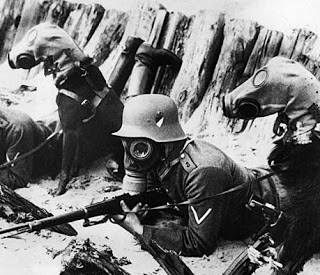US military scans dogs’ brains to find best combat soldiers
> ONE day they’ll be doing this to people:
ONE day they’ll be doing this to people:
DARPA’s mission is to prevent technological surprise for the United States and to create technological surprise for its adversaries. The DARPA SBIR and STTR Programs are designed to provide small, high-tech businesses and academic institutions the opportunity to propose radical, innovative, high-risk approaches to address existing and emerging national security threats; thereby supporting DARPA’s overall strategy to bridge the gap between fundamental discoveries and the provision of new military capabilities.
What you guys need is an acronym. A good acronym will strike fear into the hearts of the enemy. American needs:
Functional Imaging to Develop Outstanding Service-Dogs (FIDOS)
FIDOS will pick out the very best dogs:
OBJECTIVE: This effort will capitalize on first-of-its-kind neural imaging feasibility work; demonstrating functional brain activation in unrestrained dogs in response to handler cues. The objective of this effort is two-fold; first, to optimize the selection of ideal service dogs, both in operational military and therapy environments, and second, to use real-time neural feedback to optimize canine training, shortening training duration, reducing costs, and increasing learned responses.
Dogs are useful:
Military working dogs are used in a variety of operations, including bomb detection, search and rescue, and drug interdiction. Service dogs are also utilized in clinical settings, as therapy dogs to mitigate symptoms of Post-Traumatic Stress Disorder (PTSD) and Traumatic Brain Injury (TBI) in returning service members. Certain dog breeds, ideal for this work, are rare (a limiting resource) and variability in dog training and performance limits their effectiveness in operational environments. Better selection and screening of service dogs would ensure that the best dogs, with optimal motivation and trainability are selected for service.
How can it be made better?
Canine training paradigms require a cognitive revolution to take advantage of recent advances in brain imaging.
Schwaggy? What’s he talking about? Scooby goes into the MRI scanner. His brain is read:
… with this state-of-the-art canine neuroimaging tool in hand, potential high-value service dogs could be screened based on their neural activation to specific handler training cues. The hypothesis is that dogs with greater activation in the caudate nucleus in response to handler cues will be faster and easier to train.
You’re looking for compliance in the field.
…Monitoring brain activation in real-time could allow trainers to reward proper brain activation patterns indicative of associative learning. These methods could be used to quickly measure how effective a given training technique is and provide quantitative, evidence-based rationale for selecting superior training methods. They would also increase the speed and efficacy of canine training, useful in both operational and therapy domains.
And the even better news:
PHASE III: Law enforcement agencies train and use work dogs for many of the same operations as the military; therefore, transition to this customer would be seamless.
And where the dogs lead, police and soldiers will follow…
Posted: 27th, January 2013 | In: Technology Comment | TrackBack | Permalink


